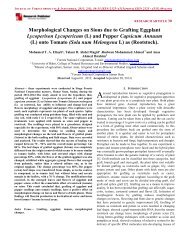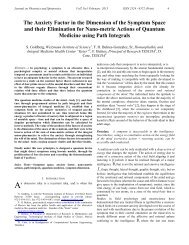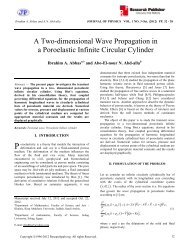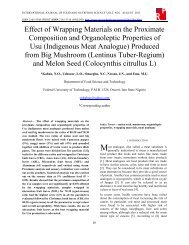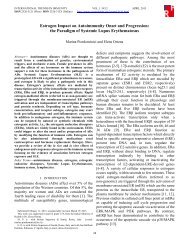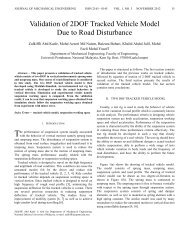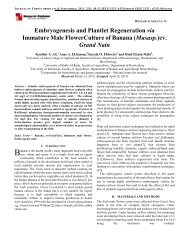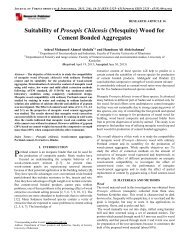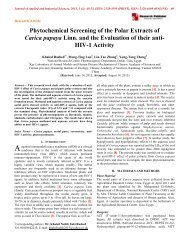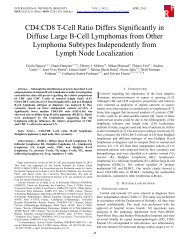Effect of Pruning Height on Growth of five Morus species
Effect of Pruning Height on Growth of five Morus species
Effect of Pruning Height on Growth of five Morus species
Create successful ePaper yourself
Turn your PDF publications into a flip-book with our unique Google optimized e-Paper software.
JOURNAL OF FOREST PRODUCTS & INDUSTRIES, 2013, 2(2), 27-30 ISSN:2325 – 4513(PRINT) ISSN 2325 - 453X (ONLINE)28characters <str<strong>on</strong>g>of</str<strong>on</strong>g> silkworm coco<strong>on</strong>s [8]. <strong>Morus</strong> Latfo1ia, M.ichikie husung, shinichiflose and M. alba were planted inNati<strong>on</strong>al Agricultural Research Centre in Islamabad in 1993 intrial for silkworm rearing. The best growth obtained was withM. latfotia, ichihie and husung respectively [9]. <str<strong>on</strong>g>Pruning</str<strong>on</strong>g> height<strong>on</strong> leaf <str<strong>on</strong>g>of</str<strong>on</strong>g> Mulberry (<strong>Morus</strong> alba) variety Kanava - 2 wasstudied by [10] showed an increase in leaf yield with higherpruning heights. Similar results were obtained for mulberryvariety Sujanpur. The result also indicated that pruning shouldnot be d<strong>on</strong>e immediately after crop harvest under thesubtropical c<strong>on</strong>diti<strong>on</strong>s. Studies revealed rearing <str<strong>on</strong>g>of</str<strong>on</strong>g> silkwormfed <strong>on</strong> mulberry leaves from plant pruned at higher stumpsheight [10]. In a study during (1977-1981) in Sao Paulo,Mulberry plants at 1.5 x 1.0 m, spacing were pruned inOctober, January and April to soil level, 15, 20, or 45 cmheights. All pruned to soil level in winter (July). Leaves andbranches were harvested (for silkworm producti<strong>on</strong>) wererecorded no significant differences between treatments inaverage leaf and branch producti<strong>on</strong> [11]. <strong>Morus</strong> lactea(Mildder) is a tree up to 26 m, bole 6-18 in high. <strong>Morus</strong>mesozygia (Stapt) large trees up to 30 - 40 m. high, bole cleanup to 20m. <strong>Morus</strong> alba anative to Asia is grown in manygardens, but with limited success [12]. Higher the survival %,better will be the performance mulberry varities. Studiesevaluated propagati<strong>on</strong> parameters <str<strong>on</strong>g>of</str<strong>on</strong>g> mulberry varieties, likesprouting survival rate and shoot growth was found asignificant variati<strong>on</strong> in growth [13]. Propagati<strong>on</strong> <str<strong>on</strong>g>of</str<strong>on</strong>g> mulberryis d<strong>on</strong>e through vegetative means such as cuttings or bygrafting so as to preserve the phenotypic characters [14].Mulberry trees are pruned in sericulture twice or three times ayear to obtain a better yield <str<strong>on</strong>g>of</str<strong>on</strong>g> leaves [15].The purpose <str<strong>on</strong>g>of</str<strong>on</strong>g> this study was to determine the effect <str<strong>on</strong>g>of</str<strong>on</strong>g>pruning height <strong>on</strong> survival and growth <str<strong>on</strong>g>of</str<strong>on</strong>g> <strong>five</strong> <strong>Morus</strong> <strong>species</strong>.II. MATERIALS AND METHODSThe study was investigated in Dindir nursery, Dindir town,Sinnar State during 2000-2003. The weather is generally hotand dry with rainy seas<strong>on</strong> between July and September. Themean annual rainfall is between 400 and 450 mm. in the Northand between 600 mm and 1000 mm, in South. Temperatureranges between 20 ° C and 42 ° C. The coolest m<strong>on</strong>ths <str<strong>on</strong>g>of</str<strong>on</strong>g> theyear are December, January, and February while the hottestm<strong>on</strong>ths are March to June.pruning. The assessment was carried from the coppice plants.The leaves and branches fresh weight per plant, wasdetermined after three m<strong>on</strong>ths from pruning height <str<strong>on</strong>g>of</str<strong>on</strong>g> the firsttreatment. Statistical analysis system (SAS) was used for dataanalysis, Duncan’s multiple range test was used to defer minesignificance <str<strong>on</strong>g>of</str<strong>on</strong>g> difference between means.III. RESULTS AND DISCUSSION<str<strong>on</strong>g>Effect</str<strong>on</strong>g> <str<strong>on</strong>g>of</str<strong>on</strong>g> pruning height <strong>on</strong> leaves and branches weightThe leaves and branches weight per pruned tree were notaffected by pruning height in the first harvest (Table 1 a).However the effect <str<strong>on</strong>g>of</str<strong>on</strong>g> pruning height was highly significant inthe sec<strong>on</strong>d harvest (Table 1 b). The weight <str<strong>on</strong>g>of</str<strong>on</strong>g> leaves andbranches was higher with high pruning height (Table a b).<str<strong>on</strong>g>Effect</str<strong>on</strong>g> <str<strong>on</strong>g>of</str<strong>on</strong>g> pruning height in coppice growth<str<strong>on</strong>g>Pruning</str<strong>on</strong>g> height had significant effect <strong>on</strong> height, leaves andbranches number in the coppice after three m<strong>on</strong>th from thefirst harvest. <str<strong>on</strong>g>Pruning</str<strong>on</strong>g> at height 40 cm gave higher valuescompared to the low pruning heights (Table 2). Theperformance <str<strong>on</strong>g>of</str<strong>on</strong>g> the original growth <str<strong>on</strong>g>of</str<strong>on</strong>g> the <strong>five</strong> <strong>Morus</strong> tested<strong>species</strong> in term <str<strong>on</strong>g>of</str<strong>on</strong>g> leaves number, leaves weight and branchesnumber, branches weight, <strong>Morus</strong> alba showed high values,followed by M. mesosygia, M. acidosa, M.inallotiflia, whileM. tiliaefolia showed low values (Table 3). This is in line withthat reported by [13].Table (1)Weight <str<strong>on</strong>g>of</str<strong>on</strong>g> leaves and branches in the first harvest and sec<strong>on</strong>dharvest at different pruning heights’(A): First Harvest (<strong>five</strong> m<strong>on</strong>th old plants)pruning height(cm)40205Weight <str<strong>on</strong>g>of</str<strong>on</strong>g> leaves(kg) p (0.8)0.75 a0.69 a0.64aWeight <str<strong>on</strong>g>of</str<strong>on</strong>g>branches(kg) p (0.75)0.65 a0.63 a0.55aPr= 0.8 0.75Means with same letter in the same columns are notsignificantly different at 0.05 level using Duncan multipletests.Uniform propagules <str<strong>on</strong>g>of</str<strong>on</strong>g> <strong>five</strong> <strong>Morus</strong> <strong>species</strong> (M. alba, M.mesozygia, M. acidosa, M. tiliaefolia and M. mallotifolia)were transferred from the nursery (Where they were raised)and planted in designated plots according to the tested spacingin April 2000 within two days period.Three pruning (Lopping) heights were applied to <strong>five</strong> <strong>species</strong>at the tested spacing the tested pruning heights were at 5 (m)20 and 40 cm from ground level. The first pruning was appliedafter <strong>five</strong> m<strong>on</strong>th from planting and the sec<strong>on</strong>d <strong>on</strong>e for thesame plants at the same heights after 3 m<strong>on</strong>ths from the first



